Text

Indigo Pizza!
Yes! There's such a thing as "Indigo pizza" here in Muroto. Actually, it's not that outrageous. Indigo is not poisonous. It's edible, even good for health.
Some say that indigo powder is a natural antiseptic. I don't know if it is scientifically proven, but as long as it's not bad for health, I don't mind seeing the blue color added to the familiar look of our everyday food.
A friend of mine and I tried three different versions of indigo pizza. The top photo is "dried baby fish and green perilla" version and you eat it with refreshing yuzu citrus dressing sauce.



This one above is a half 'n half: margherita and gorgonzola pizza. So tasty but a bit too heavy for us.

Iced chai was pretty good, too.
1 note
·
View note
Text

We harvested abundant sansho pepper this spring! Amazing! The sansho tree produced only about 20 of peppercorns last year, and I was hoping to get just a little bit more this year.
But I wasn't expecting THIS!!

Believe me. There's about this much still left on the tree.
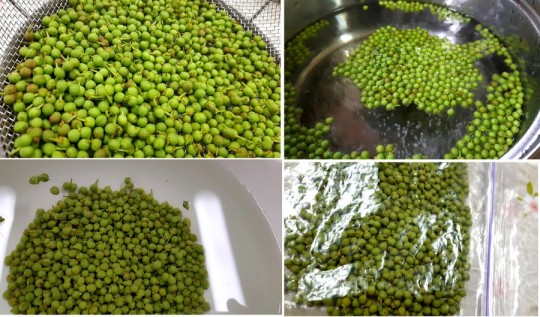
I washed, blanched, and soaked them in water for several hours. Then I froze them in a ziploc bag because I've read that it was the best way to preserve the sansho peppercorns for a long time.
Let's see how it works. ;)
0 notes
Text

A stroll under cherry blossoms with mom.
.
1 note
·
View note
Text
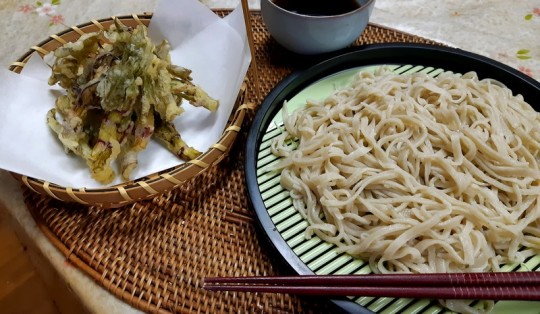
Homemade buckwheat noodles and deep-fried shoots of an edible wild plant.
One way to enjoy spring in a countryside. :)
2 notes
·
View notes
Text
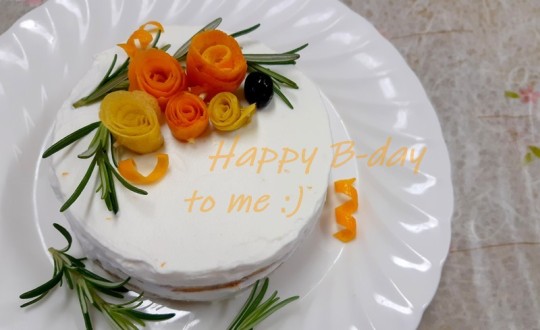
This is a homemade birthday cake for my fifty something-th birthday. :) So what do you think?

I baked the sponge the day before yesterday, using the juice of ponkan oranges from our family orchard. And I brushed the sponge with the orange syrup and kept it in the fridge. ;)
This morning, starting at 6 am, I decorated it with whipped cream, orange peel garnish, one blueberry and a couple of rosemary sprigs.


I'm very tempted to say that all the garnish ingredients were from our orchard/garden. But to tell you the truth, they are except for the orange-colored orange peel. I tried to make the flowers and curled strings with the peel of ponkan oranges from our family orchard. But I guess ponkan is not a right kind... The peels broke off so easily and were not good for rolling like this.
Anyway, I'm happy with the way it looks. After eating almost half of it, I tried another design.


I had thought about going fishing or having an expensive lunch somewhere to celebrate my special day. But the weather is not good and mom might escape the house any time. So I'll stay home, relax, enjoy this cake and Amazon prime to reward myself.
Oh, and some cocktails after my parents go to bed tonight.
;)
.
4 notes
·
View notes
Text

This is how I enjoyed the manybar goatfish I had caught the other day. :)
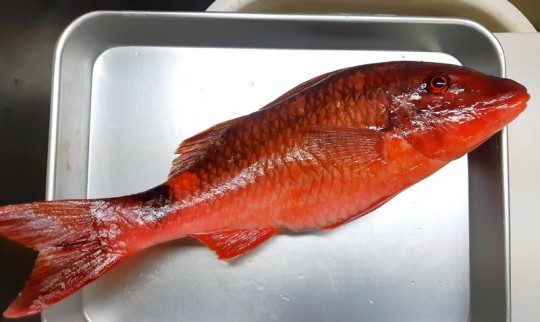
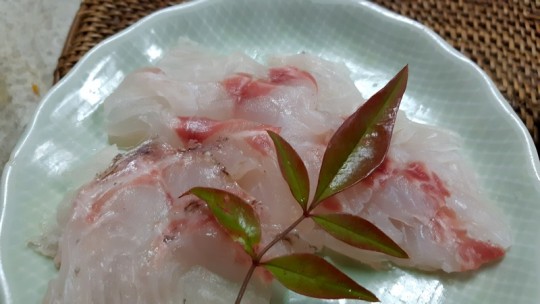
Sashimi (sliced raw) was good, though a little bland, maybe.
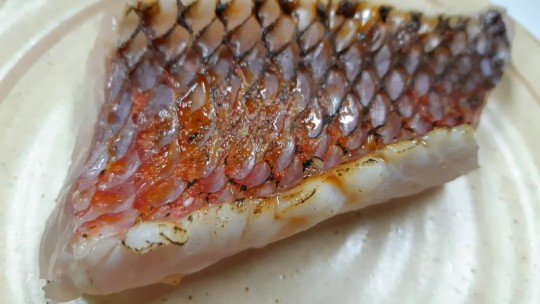
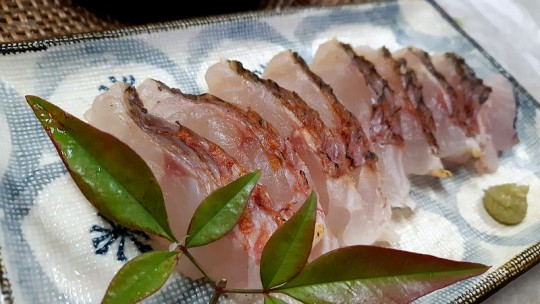
It tasted much better when it was blow-torched. The fat right underneath the skin was so tasty!
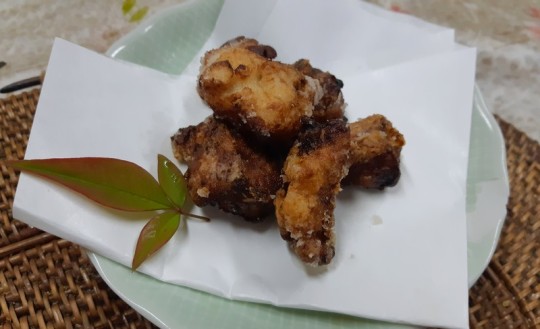
I liked this Miso-marinated and deep-fried version very much.

But my favorite was this nigiri-zushi. The sliced flesh went surprisingly well with the vinegared rice!
From now on, making nigiri-zushi will be my first choice when I catch manybar goatfish. :)
.
0 notes
Text
Project Opuntia -13 A Journalist Meets Opuntia / Project ウチワサボテン-13- 読売新聞記者サン参戦!

This time, a journalist from Yomiuri newspaper joined us to experience removing opuntia and write an article.
今回は、読売新聞の記者さんが1人、サボテン駆除を体験して記事を書くために参加してくれました。


The location was, again, the worst-affected spot near the tip of Cape Muroto.
He really struggled getting stung by the spikes.
記者サン、サボテンのトゲに刺されてかなり難儀しながら頑張って下さいました。
The newspaper article is available here in Japanese. (I tried Google's website translation tool and it worked OK, though not perfect. )
The journalist obviously did his own research and interviewed several people including the curator of the prefectural botanical garden and a University student who is writing a thesis on the opuntia problem.
Hope the particle will help raising public awareness on this issue.

-- Opuntia has been removed at these locations --
.
0 notes
Text


My catch today. Manybar goatfish. 36cm.

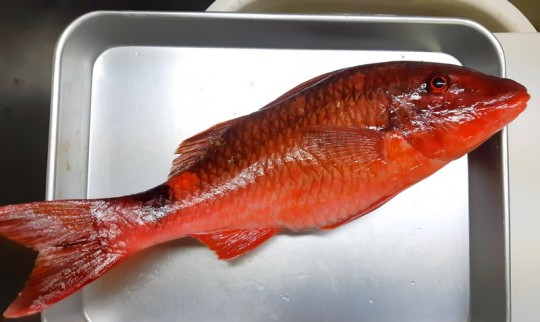
0 notes
Text
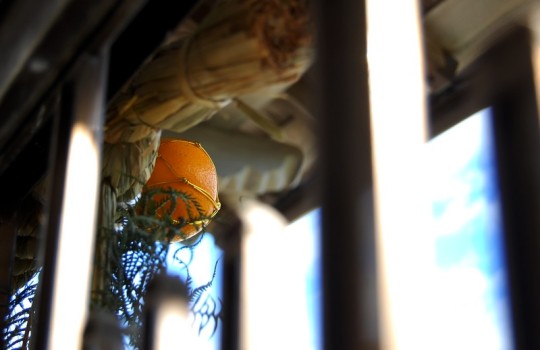
The beginning of a new year is like the beginning of a new chapter of life. It is time to put some things in the past and start anew.
Probably it’s a universal custom to wish good luck for the fresh start of the year. And people must be doing that in many different ways in different parts of the world. Different things must be associated with good luck and happiness because of their shape, color and names.
Here in Japan, people customarily relate lots of things in nature to good luck. Perhaps that is due to Shinto, the “indigenous faith” of this country. According to the faith, there are many deities residing in nature. Thus, ancient people might have seen the potentials in certain plants and animals in nature to mediate between human wishes and the deities.
Of course Japanese people today do not literally believe in the magical power of the deities and good luck charms. But they are still inclined to follow the custom just in case there is some unnatural power beyond our scientific knowledge.
In rural areas, you can still find traditional customs that were lost in big cities decades ago. My hometown is no exception. For many grandpas here, getting correct plants for New Year’s decoration has the highest priority at the end of the year. For many grandmas, failing to buy certain food ingredients for New Year’s feast is a horrible mistake that they should avoid at all costs.
For those who may be interested in such Japanese traditions, let me share some of our family tradition of New Year’s celebration as of 2023.
The God of New Year – also the God of Agriculture – is said to visit every household on the New Year’s Day to stay for a certain period to give blessing for the whole year.
This ornament is placed at the entrance to show him the way into the house.

This ornament, shimenawa is typically made with rice straw rope, ferns and an orange. And all of them are associated with good luck.
The rice straw is considered sacred because rice is the staple food here. The ferns have to be a special kind with leaves with white back. The white color is associated with gray hair, sybolizing “longevity.” The kind of orange used for this is “daidai orange” because “daidai” also means “from generation to generation” in Japanese language. Thus, this orange is associated with ”family prosperity.”
To welcome the God of New Year, light is lit at the Shinto altar in the house on the night of New Year’s Eve.
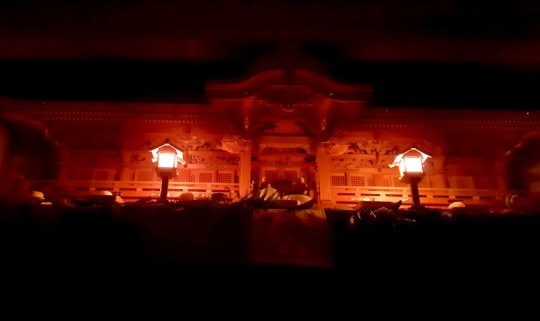
The altar is decorated with sacred rice straw ropes, talisman, rice cakes and offerings of sake, rice, salt and water.
The God is said to come onto this ornament with two big rice cakes. So it must be placed at the alcove beforehand.

When I was a child, we made these rice cakes at home by pounding glutinous rice with mortar and pestle. They usually got hard and moldy in several days so we had to soak them in water and scrape off the moldy parts to eat them. Now we buy individually-wrapped small rice cakes in a plastic container which looks like two-tiered big rice cakes.
At midnight, as soon as the date turns to Jan. 1st, I go to this old, small shrine in my neighborhood for the first shrine visit of the year. My parents go to bed early, so I need to be there on behalf of them to pray for our family’s happiness and safety in the new year.


On Jan. 1st, I wake up early to see (and take photos of) the first sunrise of the year. This sunrise is considered to be special and give you blessing for the new year.

When my parents get up at around 10 am, it is time for a traditional ceremony to celebrate the New Year.
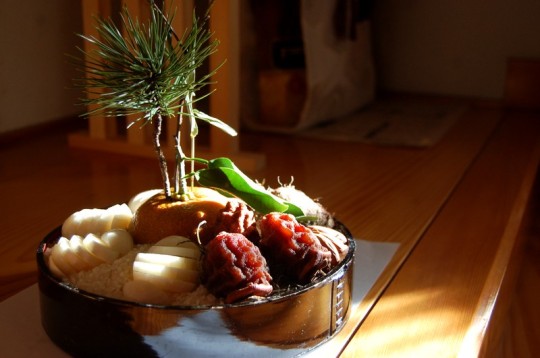
Before Meiji Restoation (1868), all people in Japan celebrated their birthdays on the same day, January 1st. So on New Year’s Day, they performed a ritual to celebrate getting one year older.
Now everyone in this country celebrates birthday independently on each person’s date of birth. But in some rural areas, people still do the ritual as a tradition on Jan. 1st and so does my family.
The most important object of the ceremony is this ornament called yone. It is literally an aggregation of ingredients symbolizing good luck.

The container is filled with raw rice, the staple food of this country. It is of special importance because it sustains people’s lives.
All the toppings are associated with good luck.
Sliced mochi (rice cake) is sacred food made from the staple food.
Daidai orange symbolizes “family prosperity” for the reason mentioned above.
Thinly-cut kobu (kelp) symbolizes happiness and joy, with its pronunciation being similar to a Japanese word yorokobu, meaning “feeling happy.”
Kachiguri (dried chestnuts which look like almonds in this photo) is associated with “victory” because kachi means "winning."
Hoshigaki (dried persimmon) means longevity because persimmon trees live long and the Kanji characters for its name can be replaced with other characters meaning “bringing happiness.”
Sprouting taro symbolizes ”prosperity of descendants” because it produces lots of tubers.
Evergreen pine sprig is associated with “longevity.” Bamboo symbolizes “strength and sincerity” because it stays green in winter. And plum, which blooms earlier than others, is a symbol of “bright future.”
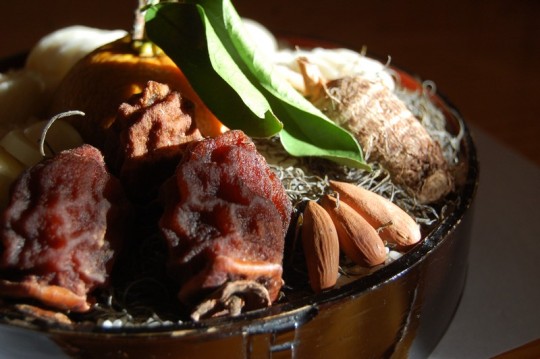
Family members gathered in the formal guest room take seats in front of the alcove and pass this ornament around. Starting with the head of the family, each person holds it with both hands a little higher than his/her head to thank God for their becoming one year older and pray for family’s happiness.
Then the person takes a sip of otoso, sake which is supposed to share some magical power of the God of the New Year. After purifying the body with the sacred sake, eating one piece of dried and grilled squid follows.

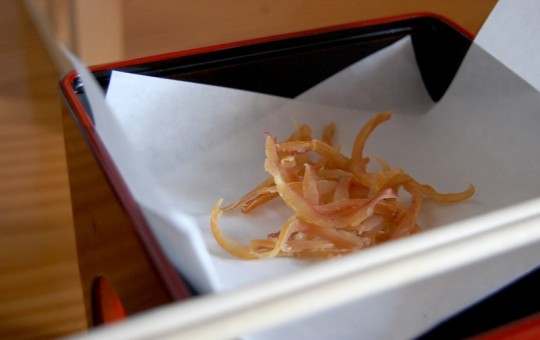
After the sake ritual, it is time for tasting zoni, rice cake soup. It is still part of the ritual, so only a small portion is served.


Our family’s zoni is VERY different. Usually some kind of vegetable is included in this soup. But our zoni has threaded kelp, yellowtail and rice cake cubes. That’s it. And lots of yellowtail bones are used for taking the broth. When my sister’s husband from a different prefecture tasted our zoni soup for the first time, he was almost overwhelmed by the strong fish flavor.
When I was a child, my mom put kimono (national traditional costume for formal occasions) on my sister and I for this special ceremony. And I was allowed to put some lipstick on only for the ceremony. Because of that, my lips felt strange while I was eating the zoni soup, but it felt very special.
The ceremony takes place in a traditional Japanese style room. Basically family members have seats on the cushions placed on the tatami floor. It is not very comfortable, honestly speaking, so as soon as the rituals are done, my family always rush to the dining room. There, comfortably sitting in chairs, we enjoy osechi (New Year’s feast) with a bowlful of warmed zoni soup.
And again, almost all foods are associated with good things like prosperity, health, longevity and good luck. Again, it is like all kinds of wishes packed in tiered lacquer food boxes.
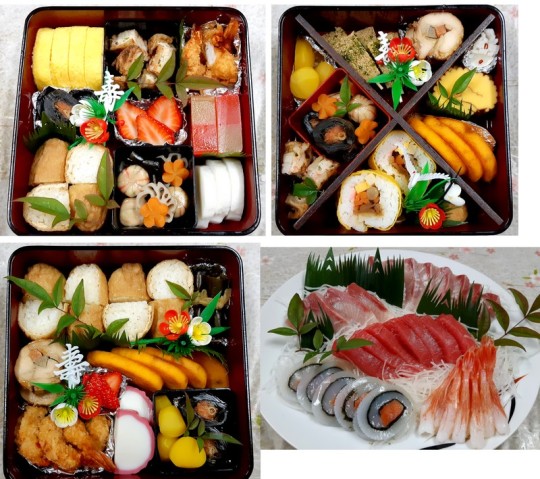

——– ——— ——–
So what do you think?
The whole thing is an overwhelming degree of wish-making, isn’t it? Here people embody lots of wishes in so many ways. Living in a country prone to natural disasters may be part of the reason why.
Now everyone in Japan is educated with modern science. Younger generations do not literally believe in superstitions and/or traditional religious customs coming from Shinto and Buddhism. But still, people here seem to be trying to maintain the good thoughts underlying all the wish-making. And for me, wishing happiness for loved ones is not the matter of being scientific vs unscientific any more.
If making one’s wishes visible and touchable makes people stronger, more hopeful and motivated, maybe it is a wisdom rather than a blind obedience to unscientific nonsense. And traditional customs give the elderly something to pass down to the youth and make them feel being part of a big continuum. That’s the way I see this whole thing.
There is a beauty in it, I think …
unless you become a slave of the tradition.
***********************
#new year's day 2023#shimenawa#traditional New Year's ceremony#kagami mochi#gantan#osechi#otoso#zoni
2 notes
·
View notes
Text

0 notes
Text

Be filled with wonder.
Be touched by peace.
1 note
·
View note
Text
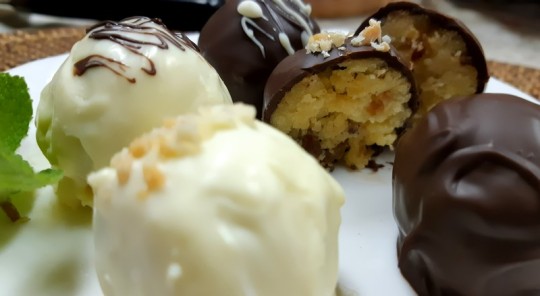
This happened at the end of November.
I thought I was invited to a potluck party on Saturday. I had promised to bake strawberry cakes, so I made about 20 cup capes and brought them to the venue.

... And there was no one there...
I called my friend and asked if I came to a wrong place. Then she told me that the party was Sunday evening, not Saturday!
OMG!!!
How could I make such a stupid mistake?!
And what should I do with the cupcakes?!
I can't eat THIS many. My parents don't like cakes. I couldn't think of anyone else who would rescue the cakes.
So what did I do?
First, I scraped off the topping (cream and strawberries), put it in a ziploc bag and froze it.
And the cakes were…


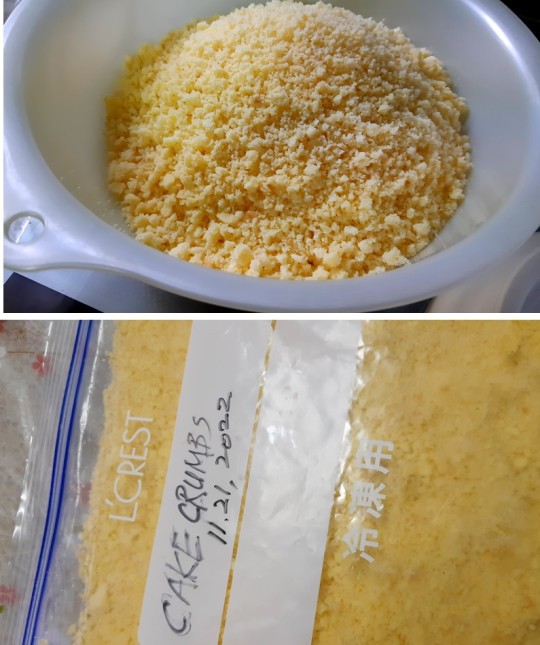
... made into crumbs and frozen.
This way, I could avoid wasting 20 cupcakes -- the result of the frantic effort I made Saturday morning. Phew!!
And the other day, I thawed the cake crumbs and made these.


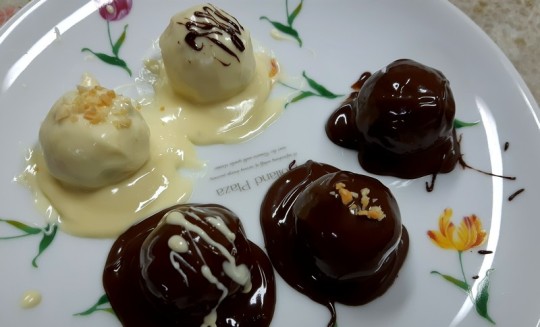
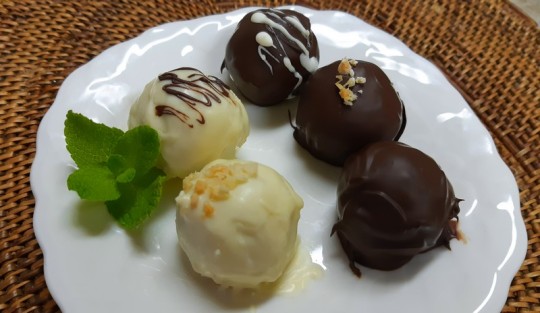
Many thanks to the leftover/failed cake recipes on the internet.
💕
.
3 notes
·
View notes
Text
Project Opuntia -12 Welcome to an Award-winning Project! / Project ウチワサボテン-12- 奨励賞に輝いた取り組みの体験ツアーへようこそ

Today we (Geopark's conservation team) removed opuntia with some helpers. They were participants of an experience tour for those who are interested in promoting biodiversity. The tour was hosted by the organization which awarded us an encouragement award, and the participants were here to experience the award-winning project.
ジオパーク推進チームの「まもるチーム」は、先だって「ふるさとのいのちをつなぐこうちプラン大賞」の奨励賞をもらいましたが。この受賞チームの活動を体験しようというツアーが組まれていて、生物多様性の推進に関わる人達に募集をかけていました。そのツアーで、今日、まもるチームとツアー参加者が一緒に、ウチワサボテンの駆除を決行!
The forecast was calling for rain, but it turned out to be a hot, sunny day.
First we gave a presentation on our "Project Opuntia" in a hotel with the hotel owner talking about the history of a local traditional custom of having meals on the beach.
雨を覚悟してたのがなんとピーカンで、夏日並みの暑さの中。まずは岬観光ホテルで、私たちの取り組み説明。ホテルのオーナーさんから、室戸の浜弁当の歴史についてのスペシャルプレゼン付きです。
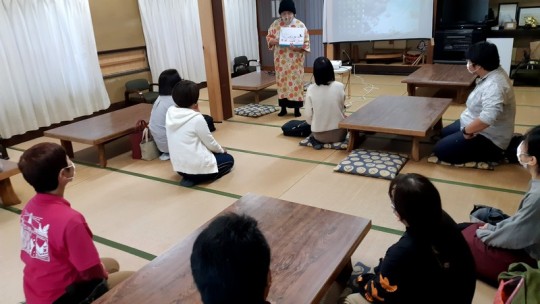
Next we enjoyed wonderful bento on the beach and after that, worked hard to remove this alien species at the worst-affected spot near the hotel.
その後、ホテルのすぐ下の浜で浜弁当ののち、あの『サボテンの惑星』と化した場所で駆除活動。

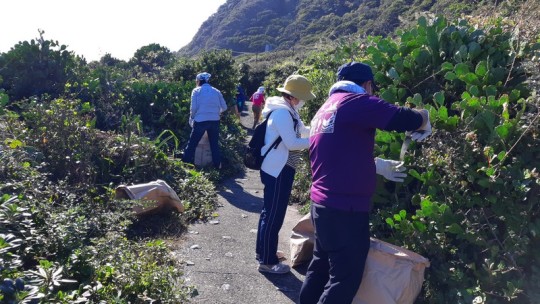
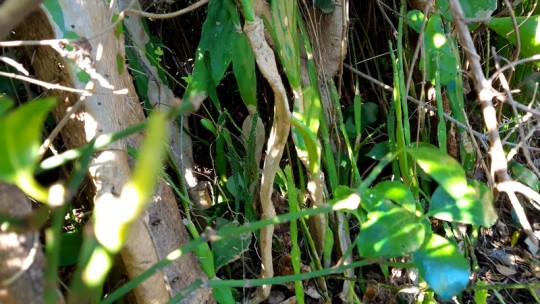
The newcomers were enjoying it in the beginning, then got tired of being stung by the spikes, and finally hated the plant. LOL They really understood how hard it was to remove this invasive plant.
初めての体験者たちは、最初のうち茎を切るのも結構楽しんでいたのが、だんだんトゲに刺され、やってもやってもキリないのに疲れ、根元の茂みをかき分けると、若い新芽がズラリと林立してるのに萎え...。だんだん、この外来種への憎しみや怖さが生まれてきた、と言った参加者さんもいました。ww

最後には、いつも通りジオパークセンターに車で運んで、ゴミ収集場所に並べて作業終了。そしてジオカフェでジオソフトや飲み物を楽しみながら、振り返り会。^^)

Chatting in the cafe at Geopark Center, we found out that opuntia problem has been reported several places in the prefecture, and our Cape Muroto is suffering the most. It was nice to feel connected with others facing the same problem.
初めての人たちの感想や、県内の他の箇所でも、ウチワサボテンの問題が顕在化してきた話を聞き。どうやら室戸岬が、県下でもイチバン繁殖がスゴイようで。これからの課題などを色々話せて良かったデス。

-- Opuntia has been removed at these locations -
.
0 notes
Text

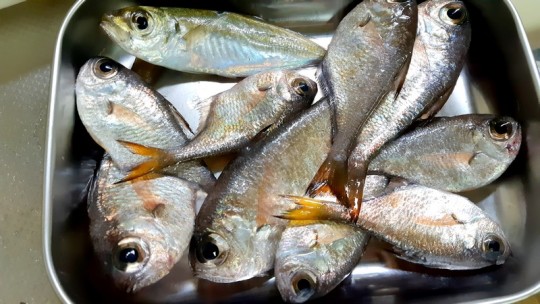

I love making sun-dried fish at home. Store-bought ones are often too salty for me.
These are silver bullseye (and one horse mackerel).
These small, flat fish with big eyes make great appetizer when sun-dried and lightly grilled.
This is how I prepared the fish.
I cut them open...
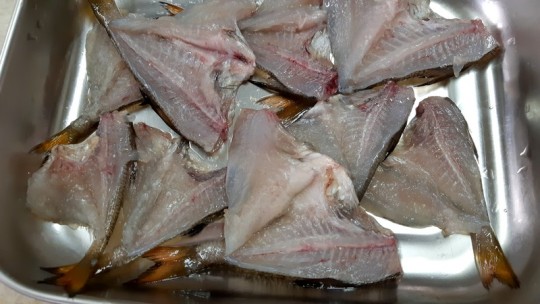
... soaked them in 3% salt water for 16 minutes...

... then dried them in the sun for 2 days.

So great with sake!! :D

.
2 notes
·
View notes
Text
Project Opuntia -11 High School Kids' Project / Project ウチワサボテン-11- 高校生がサボテン食べちゃうゾ!

This time, we didn't go to the coastal trail. Instead, we chose to work along the National Road Route 55. Near the national road, there are two sea caves which are relatively known as a sightseeing spot. And near those caves, there is an opuntia bush that keeps spreading no matter how local people try to stop it.
And this time, we had two special helpers!
今回はいつもの海岸遊歩道ではなく、国道55号沿いでの駆除。観光地として知られた2つの海蝕洞があり、その近所に、どんなに食い止めようとしても広がり続けてる、ウチワサボテンの茂みがあるんです。
そして今回は、特別な助っ人が2人!

They were local high school students in "Geopark Study" course. As a course requirement, they chose to learn about the problem of invasive plants. And they came up with an idea of using opuntia as food! So they joined us to help removing an invasive plant, opuntia, and get some ingredient for their culinary experiment.
彼らは地元室戸高校の「ジオパーク学」を履修している高校生のS君とK君。彼らはそのクラスの中で「外来種生物」のテーマを選んでいて、2人でウチワサボテンを食べ物として使うプロジェクトをやっているそうです。で、今回、外来種の駆除を手伝い、調理プロジェクトの材料にするウチワサボテンを入手しに来てくれたわけで。

They sure were a great help. They were so into the work and we heard them going, "Ouch!" "Oh, no!" so many times.
さすが、若い学生さんは強力な助っ人です。熱心に駆除してる彼らのところから、「あ痛っ!!」という声が何度も響き渡りました。^^)
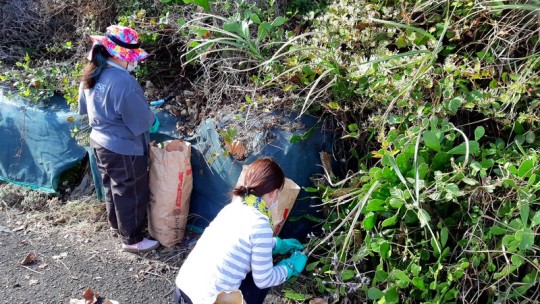
Of course regular members of our team worked hard as usual. :)
もちろん、まもるチームのレギュラーメンバー達も、いつも通りの大奮闘です。
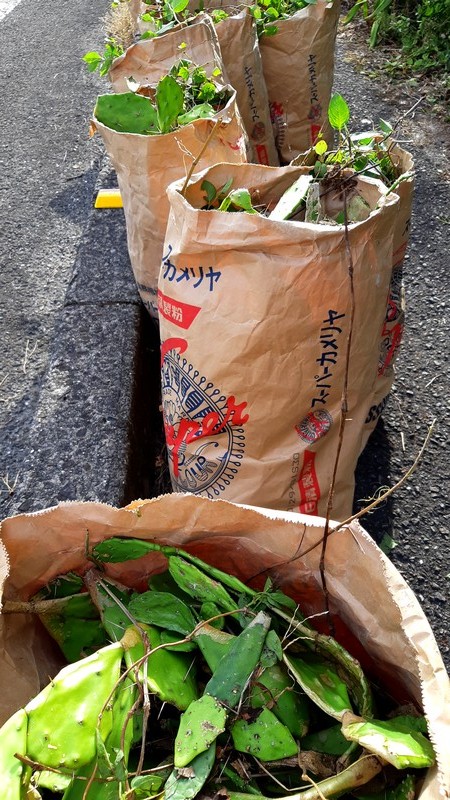
The opuntia bush was much bigger and the work was much harder than we had thought. This many bags were filled with removed opuntia. But actually, we only removed them from limited spots here and there and that was it.
ウチワサボテンの茂みは思ったより大きくて、駆除したサボテンを詰めた袋がこんなに出来ても、実際取り除けたのは、限られたスペースでそれも数か所で。
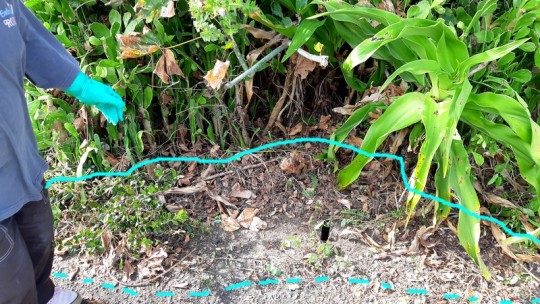
This section does show the difference, though.
駆除した甲斐が顕著にみられるのはこの部分ですね。↓



The weed control sheet was pushed up by the opuntia like this before. Now the invasive plant there is gone and the sheet is back at its original position.
防草シートらしきものがウチワサボテンに持ち上げられてたのが、サボテンは完全に?なくなって、シートももとの場所に。


It was indeed a lot of work. Usually the bags count 15 or 16 and probably 20 something was the largest number so far. But this time, with the young helpers, we ended up with more than 30 bags!
いやぁよく働きました。駆除したサボテンの袋詰めは、たいてい15,6袋、今までのMAXで20袋あたりだったと思いますが。今回は若い助っ人のおかげて30袋ほどに!
And the high school kids said that they were going to try making kimuchi and pickles with the opuntia. Can't wait to hear how the experiment went! :D
そして高校生たちはこのウチワサボテンで、キムチと浅漬けを作ってみるそうです。
どんなものが出来るでしょうか!?まもるチーム一同、大きな期待を持って、結果を聞くのを楽しみにしております。

Opuntia has been removed at these locations -
0 notes
Text


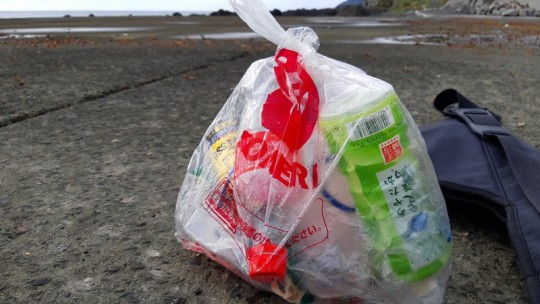

1 note
·
View note
